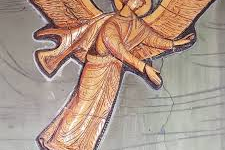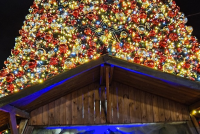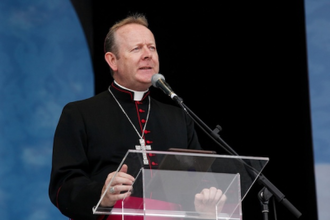Carmelite Shrine at Aylesford awarded listed building status

The beautiful medieval Pilgrims' Hall at The Friars, seen from across the River Medway.
The Shrine of Our Lady of Mount Carmel and Saint Simon Stock at Aylesford Priory in Kent, a site of great significance for the whole Carmelite Order and for the Catholic community in England and Wales, has been granted listed building status.
2017 marks 70 years of the practice of listing, which was introduced in the Town and County Planning Act in 1947 to protect important properties from destruction in the period of re-building and urban development after World War II.
Today listed status is granted to buildings and sites which have special architectural, historical, or cultural significance. One of three grades can be applied to listed properties:
Grade I buildings are of great interest, sometimes considered internationally important; only 2.5% of listed buildings are Grade I.
Grade II* buildings are particularly important buildings of more than special interest; 5.8% of listed buildings are Grade II*.
Grade II buildings are nationally important and of special interest; 91.7% of listed buildings are Grade II.
Listing is not a preservation order, preventing change or freezing a building in time; rather it identifies and protects important buildings by requiring consent before any changes can be made to a building which might affect its special interest.
The Carmelites first came to Aylesford from Mount Carmel in 1242. Aylesford became important in the Carmelite Order's sense of identity and spirituality; it was here that the first General Chapter took place in 1247 which led to the Carmelite hermits becoming mendicants (begging brothers), and later legends claimed that it was here that the prior general of the Order, Saint Simon Stock, received a vision of the Blessed Virgin Mary who blessed the scapular of his religious habit. The medieval priory was a place of worship and study, offering hospitality to pilgrims travelling between London and Canterbury. At the Reformation of the 1530s, the priory passed into private ownership, but continued to be known as "The Friars". The Carmelite Order was able to purchase back The Friars in 1949, and since then the priory has developed as a major site of pilgrimage for Catholics and Christians of other denominations, welcoming about a quarter of a million visitors each year.
The main block of medieval priory buildings received listed status in 1959, being granted the highest level of Grade I in recognition of its international historic importance.
In 1987 listed status was granted to other parts of the site: the 15th-century Gatehouse (Grade I); the 17th-century timber-framed barn (Grade II); and the late 17th-century Court Lodge farmhouse (Grade II).
Most recently, in September 2016, Grade II* listed status was granted to the Shrine of Our Lady of Mount Carmel and Saint Simon Stock at Aylesford Priory. The Main Shrine and its associated chapels were designed by Adrian Gilbert Scott and built between 1958 and 1965 under the inspirational leadership of Carmelite prior Fr Malachy Lynch. A biography of Fr Malachy and account of his work at Aylesford, by Fr Wilfrid McGreal, has recently been published.
The Shrine was built was response to the large number of pilgrims wanting to come and pray at the site, and its chapels were adorned with artworks and furnishings by Adam Kossowski, Michael Clark, Dom Charles Norris, and others. The Shrine complex of buildings consists of: the Main Shrine to Our Lady; the Relic Chapel (of Saint Simon Stock, with side chapels dedicated to the Saints of Carmel and the Martyrs of England and Wales); the St Joseph Chapel; and St Anne's Chapel.
The official record of the listing highlights the Shrine's:
Historic and religious interest: as an especially notable example in England of an ancient monastic site being 'reclaimed' as a place of modern pilgrimage
Architectural interest: its quiet contextualism, combined with a highly ingenious plan-form and open-air worship space, distinguish it as a particularly unusual example of post-war religious architecture, by a Roman Catholic architect of note
Artistic interest: as well as artworks from several renowned Catholic artists, the building is enriched by a broad and impressive scheme of artworks and liturgical furnishings by Adam Kossowski.
Craftsmanship: as a series of complete, bespoke, interiors, featuring metalwork, joinery and glass, designed primarily by Scott and Kossowski, and made by local craftsmen
Group value: as a creative and successful intervention in the fabric and setting of an ancient site, the building has strong group value with the restored monastery buildings, listed at Grade I.
The Shrine's listed status was granted by the Secretary of State for Culture, Media, and Sport, on the recommendation of Historic England, the public body that looks after England's historic environment. In its listing selection, Historic England is particularly discerning of buildings from the period after 1945, to ensure that only the best or most unusual buildings are preserved. Particular criteria also exist for the listing of places of worship.
As well as being a great tribute to the work of Fr Malachy, the skillful efforts of the builders, and the generosity of volunteers who worked on the Shrine, it is hoped that the new listed status will help the Carmelites to secure conservation grants for historic buildings, as the Order looks at various ways to ensure The Friars continues to be a place of prayer and hospitality in the future.
Read more about Aylesford Friary here: www.carmelite.org/aylesford
















